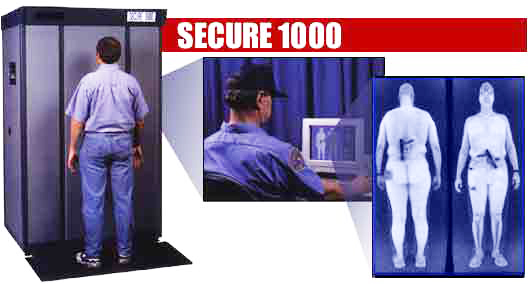
The Rapiscan Secure 1000 has been called a “virtual strip search.” It shows a person’s private parts but obscures the face. Bush’s Homeland Security Secretary Michael Chertoff heads the so-called full body scanner lobby.
In Illinois, federal judges have allowed at least two lawsuits to proceed against correctional officials for using full body scanners to reveal the anatomy of both prisoners and visitors without removing their clothing. This is the very same device that airports are seeking to implement on some inbound flights to the United States.
The cases of Young v. County of Cook, 2009 U.S. Dist. Lexis 64404(N.D. 111.), and Zboralshi v. Monohan, 616 Supp.2d 792, 798 (2006, N.D. Ill), explain, “A Rapiscan is a machine that uses ‘back-scatter’ x-ray technology to conduct a body scan.” There is no significant difference between using Rapiscan and computer tomography (CT scan) whole body scanning.
Despite the clearance of some CT scanners (Rapiscan), the FDA’s website shows that no data has ever been presented to the agency as to the safety of these devices and states that it has never approved these devices as being safe because “some Food and Drug Administration officials were worried that full-body CT screening scans (Rapiscans) ‘may be exposing thousands of Americans to unnecessary and potentially dangerous radiation’ and that CT scans of the chest delivered 100 times the radiation of a conventional chest x-ray … between .2 to 2 rads of radiation during a single scan.” See, e.g., Virtual Physical Ctr-Rockville, LLC v. Philips Med. Sys., 478 F.Supp.2d 840, 842-43(D. Md. 2007) and “FDA Raises Body Safety Issue” by Marlene Cimons in the Los Angeles Times, June 5, 2001.
The Federal Bureau of Prisons officials have been forcing inmates at USP Big Sandy to submit to random computerized tomographic whole body radioactive scanners. If they refuse to submit to these radiation experiments, prison officials are charging them with disobeying a direct order and subjecting them to a wide range of sanctions, including but not limited to loss of good time credits, resulting in an extended time in prison, even if they agree to be subjected to an ordinary visual strip search as a reasonable alternative to radiation exposure from the whole body scanner. These images are saved and viewed by male and female staff and available online to certain civilian populations.
Regulations at 28 CFR §§ 512.11 and 512.12 prohibit the government from using inmates for this type of experimentation and require them to give both the inmates and the public notice of their intent to use inmates as test subjects as well as all of the possible effects related to being subjected to any such experimentation – and then only on a voluntary basis. See also Administrative Procedure Act, 5 U.S.C. § 551(4) and 5 U.S.C. § 553(b)-(d).
Federal regulations also prohibit the use of x-ray, MRI or similar devices on inmates for any reason other than legitimate medical purposes or only when there exists reasonable suspicion that the inmate has recently secreted contraband – and then only by a licensed practitioner in the manner set out in 28 CFR §§ 552.13(b)(1) and 541.48.
Read moreUS prisoners forced to submit to radiation experiments for private foreign companies


